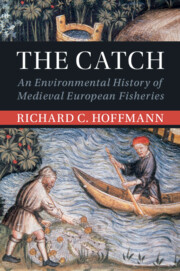Book contents
- The Catch
- Studies in Environment and History
- The Catch
- Copyright page
- Dedication
- Additional material
- Contents
- List of Figures
- List of Maps
- Preface and Acknowledgements
- Abbreviations Used in Notes and Bibliography
- Introduction
- 1 “Natural” Aquatic Ecosystems around Late Holocene Europe
- 2 Protein, Penance, and Prestige
- 3 Take and Eat
- 4 Master Artisans and Local Markets
- 5 Aquatic Systems under Stress, c. 1000–1350
- 6 Cultural Responses to Scarcities of Fish
- 7 Going beyond Natural Local Ecosystems, I
- 8 Going beyond Natural Local Ecosystems, II
- 9 Last Casts
- Appendix A Glossary of European Fishes Named in This Book
- References
- Index
3 - Take and Eat
Subsistence Fishing in and beyond the Early Middle Ages
Published online by Cambridge University Press: 11 May 2023
- The Catch
- Studies in Environment and History
- The Catch
- Copyright page
- Dedication
- Additional material
- Contents
- List of Figures
- List of Maps
- Preface and Acknowledgements
- Abbreviations Used in Notes and Bibliography
- Introduction
- 1 “Natural” Aquatic Ecosystems around Late Holocene Europe
- 2 Protein, Penance, and Prestige
- 3 Take and Eat
- 4 Master Artisans and Local Markets
- 5 Aquatic Systems under Stress, c. 1000–1350
- 6 Cultural Responses to Scarcities of Fish
- 7 Going beyond Natural Local Ecosystems, I
- 8 Going beyond Natural Local Ecosystems, II
- 9 Last Casts
- Appendix A Glossary of European Fishes Named in This Book
- References
- Index
Summary
For centuries up to about 1000 CE, and in many settings also long thereafter, medieval Europeans ate almost exclusively the fishes available in their nearby waters, fresh or marine. Predominant technologies and institutional arrangements could not easily or safely move fish or fish flesh more than a few days from the point of capture. Peasant households with local knowledge of seasonally available stocks took fish ‘for their own table’. Local communities with de facto access to waters defended customary uses on what later writers would call fisheries commons. Much better documented, however, were those subordinates obligated to supply fish for the tables of their social superiors and masters. For some this was routine labour service, but for a few it was full-time employment and expertise. Small gear handled by individuals could provide family subsistence, while crew-served equipment targeting seasonal concentrations served the larger demands of ruling elites. Depending on the fish variety and season, short-term preservation methods (salting, drying, smoking) might keep a catch edible for short-run future use. Local and regional variations on these practices were ubiquitous.
Keywords
- Type
- Chapter
- Information
- The CatchAn Environmental History of Medieval European Fisheries, pp. 89 - 132Publisher: Cambridge University PressPrint publication year: 2023



